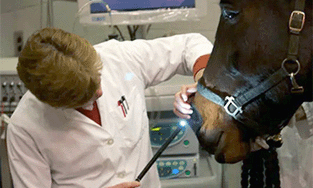How Endoscopy is Revolutionizing Veterinary Medicine.
- Share
- publisher
- 易溦
- Issue Time
- May 24,2025
Summary
Endoscopy has emerged as a cornerstone of modern veterinary medicine, offering unparalleled precision in diagnosing and treating conditions in animals.

Veterinary endoscopy is revolutionizing how veterinarians diagnose and treat animal health issues. By utilizing high-resolution flexible or rigid scopes, veterinarians can visualize internal organs in real time. This minimally invasive approach reduces patient trauma, enhances diagnostic accuracy, and enables faster recovery compared to traditional imaging techniques.
1. What Is Veterinary Endoscopy?
Veterinary endoscopy uses flexible or rigid scopes with high-resolution cameras to explore internal organs without the need for surgical incisions. Whether it’s gastroscopy, bronchoscopy, cystoscopy, or arthroscopy, this technique offers clearer, direct insights compared to traditional imaging, helping vets make faster, more accurate decisions.
2. Precision Diagnostics: Seeing Beyond the Surface
Veterinary endoscopy surpasses conventional imaging like radiography and ultrasound by offering a direct, magnified view of internal structures. Chronic gastrointestinal symptoms in dogs or nasal discharge in cats can be accurately diagnosed via gastroscopy or rhinoscopy. This level of visual detail reduces diagnostic guesswork and leads to more effective treatment plans.

3. Minimally Invasive Surgery: Safer and Faster
Endoscopic surgery eliminates the need for large incisions in procedures like foreign body retrieval. According to the Journal of Veterinary Surgery, 89% of esophageal obstructions in dogs were resolved endoscopically, avoiding thoracic surgery. This reduces infection risk, postoperative pain, and recovery time.
4. Enhanced Biopsy Collection: Targeted and Accurate
With endoscopic guidance, veterinarians can collect precise biopsies from areas like the bladder, colon, or respiratory tract. A 2023 veterinary oncology report showed a 40% improvement in lymphoma diagnosis accuracy compared to traditional biopsy techniques. Early detection of cancer means more treatment options and better outcomes.
5. Respiratory Tract Evaluations: Real-Time Airway Assessment
Brachycephalic breeds such as Bulldogs often suffer from airway issues. Bronchoscopy and tracheoscopy allow vets to assess problems like laryngeal paralysis or tracheal collapse without open surgery. In many cases, stents can be placed during the same procedure, improving airflow and quality of life.
Case Example: A Persian cat with chronic sneezing underwent rhinoscopy, which revealed a nasal polyp that was removed endoscopically, avoiding invasive surgery.
6. Urologic Applications: Non-Invasive Stone Management
Cystoscopy enables minimally invasive bladder stone removal. In male cats prone to urethral blockages, laser lithotripsy performed endoscopically fragments stones without surgical incisions. This has reduced feline urinary obstruction mortality rates by over 60%, as per a 2022 study in Veterinary Urology.

7. Arthroscopy: A New Standard in Joint Care
Veterinary arthroscopy is widely used to diagnose and treat joint issues in both small animals and horses. For example, cranial cruciate ligament (CCL) injuries in dogs and osteochondritis dissecans (OCD) in horses are now commonly treated endoscopically. Recovery times are typically 30–50% faster than with open joint surgery.
8. Client Education and Trust: Seeing Is Believing
Veterinary endoscopy also enhances client communication. Clinics that show pet owners visual evidence of internal issues through endoscopic imaging report a 35% increase in compliance with treatment recommendations. Transparency builds trust and reinforces the value of veterinary services.
9. Cost-Efficiency: Long-Term Savings
Although endoscopic systems require initial investment, the long-term savings are significant. Clinics benefit from increased procedure volume and reduced hospitalization times. For pet owners, avoiding surgical recovery and overnight stays can lower treatment costs by up to 40%.
10. Exotic Animal Care: A Breakthrough for Small and Unique Species
Endoscopy provides safe diagnostic access to internal organs in exotic species such as reptiles and birds. Procedures like cloacoscopy in parrots or liver biopsy in bearded dragons can now be performed with minimal risk, improving care options for these delicate patients.


11. Future Trends: AI and Disposable Endoscopes
Emerging technologies are pushing the boundaries of veterinary endoscopy. AI-assisted diagnostics can detect abnormalities in real time, while disposable endoscopes reduce infection risks and are more affordable for small practices. The global veterinary endoscopy market is projected to grow at an 8.7% CAGR through 2030, driven by these innovations.
Conclusion: The Future Is Minimally Invasive
Veterinary endoscopy is not just a tool—it is reshaping modern animal medicine. From accurate diagnostics and faster recovery to improved client relations and cost savings, endoscopy offers wide-ranging benefits for clinics and patients alike. As technology evolves, embracing these innovations ensures better outcomes for animals and sustainable growth for veterinary practices.
Ready to upgrade your endoscopic capabilities?
Explore our full range of portable veterinary endoscopes and accessories at JeetVet's Product Page.